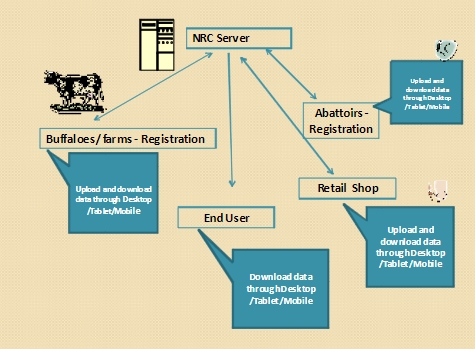A database for buffalo meat traceability in India
DOI:
https://doi.org/10.56825/bufbu.2023.4233581Keywords:
Bubalus bubalis, buffaloes, traceability, meat, India, databaseAbstract
Farm-to-fork traceability has emerged as benchmark for meat quality assurance in the International meat market. India is the largest exporter of buffalo (Bubalus bubalis) meat in the world; nevertheless, need for indigenous traceability system based quality assurance protocols to enable exports to the developed countries has been increasingly emphasized. To address this gap, a complete protocol for achieving traceability was conceptualized and a traceability database (www.livestocktraceindia.in) was developed to support the Indian buffalo meat sector. Traceability model and the database established was field tested. This article provides brief information of the traceability framework and the mode of its operation. The traceability database encompasses enrolment of animals, farms and abattoirs. Animal identification was achieved using ear tags with Internationally accepted identification numbers. Premises including farms and abattoirs were identified using unique pin code based system. Provision was given to end user to retrieve information and trace back the origin of meat using the database’s retrieval system. Database and traceability protocols developed can help promote livestock sector, meat traceability and meat export in India. The database can act as model for establishment of traceability system in other countries producing and exporting the buffalo meat.
Downloads
Metrics
References
Bai, H., G. Zhou, Y. Hu, A. Sun, X. Xu, X. Liu and C. Lu. 2017. Traceability technologies for farm animals and their products in China. Food Control, 79(2): 35-43. DOI: 10.1016/j.foodcont.2017.02.040
Department of Animal Husbandry, Dairying and Fisheries. 2019. Provisional Key Results of 20th Livestock Census, New Delhi, India
European Commission. 2000. Regulation (EC) No 1760/2000 of the European Parliament and of the Council of 17 July 2000 establishing a system for the identification and registration of bovine animals and regarding the labelling of beef and beef products and repealing Council Regulation (EC) No 820/97. Official Journal of the European Communities, Available on: http://eurlex.europa.eu/LexUriServ/LexUriServ.do?uri=OJ:L:2000:204:0001:0010:EN:PDF
FSSAI. 2017. Guidelines for Food Recall. Food Safety and Standards Authority of India, New Delhi, India
INAPH. 2019. Information Network for Animal Productivity and Health. National Dairy Development Board, New Delhi, India
Kassahun, A., R.J. Hartog, T. Sadowski, H. Scholten, T. Bartram, S. Wolfert and A.J. Beulens. 2014. Enabling chain-wide transparency in meat supply chains based on the EPCIS global standard and cloud-based services. Comput. Electron. Agr., 109: 179-190. Doi: 10.1016/j.compag.2014.10.002
Kruize, J.W., J. Wolfert, H. Scholten, C.N. Verdouw, A. Kassahun and A.J. Beulens. 2016. A reference architecture for farm software ecosystems. Comput. Electron. Agr., 125: 12-28. DOI: 10.1016/j.compag.2016.04.011
Schroeder, T.C. and G.T. Tonsor. 2012. International cattle ID and traceability: Competitive implications for the US. Food Policy, 37(1): 31-40. DOI: 10.1016/j.foodpol.2011.10.005
Shanahan, C., B. Kernan, G. Ayalew, K. McDonnell, F. Butler and S. Ward. 2009. A framework for beef traceability from farm to slaughter using global standards: an Irish perspective. Computers and Electronics in Agriculture, 66(1): 62-69. DOI: 10.1016/j.compag.2008.12.002
Kandanuri, V. 2019. Indian buffalo meat exports: Issues of growth, instability, concentration. Buffalo bull., 38(3): 505-520. Available on: https://kukrdb.lib.ku.ac.th/journal/BuffaloBulletin/search_detail/result/390949
Wilson, D. and P.T. Beers. 2001. Global trade requirements and compliance with World trade organization agreements: The role of tracing animals and animal products. Rev. Sci. Tech. OIE, 20(2): 379-382. DOI: 10.20506/rst.20.2.1278
WTO. 2015. The World Trade Organization Agreement on the Application of Sanitary and Phytosanitary Measures (SPS Agreement). Available On: https://www.wto.org/english/tratop_e/sps_e/spsagr_e.htm
Zhang, X., J. Zhang, F. Liu, Z. Fu and W. Mu. 2010. Strengths and limitations on the operating mechanisms of traceability system in agro food, China. Food Control, 21(6): 825-829. DOI: 10.1016/j.foodcont.2009.10.015
Zhao, Y., B. Zhang, G. Chen, A. Chen, S. Yang and Z. Ye. 2013. Tracing the geographic origin of beef in China on the basis of the combination of stable isotopes and multielement analysis. J. Agr. Food Chem., 61(29): 7055-7060. DOI: 10.1021/jf400947y









.png)








